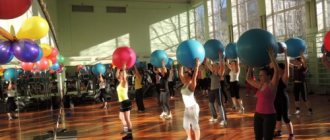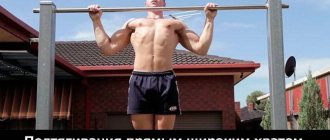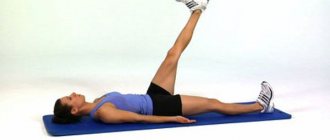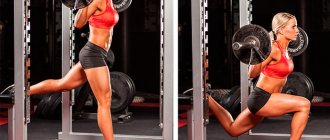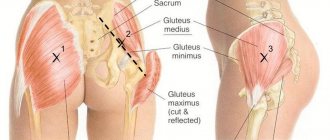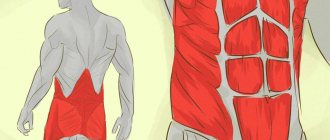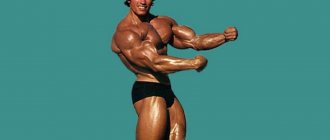Let's start with the most important things
We won’t bore you and in a telegraphic style, we will briefly, or almost briefly, describe the most necessary facts that you should know before you start pumping your abs:
- There are 4 main muscle groups of the abdomen: the transverse abdominis muscle, the internal and external obliques, the rectus abdominis muscle, which is what we call the abs . Although different exercises engage the abdominal muscles in different ways, there is no such thing as “top” and “bottom” abs. During the exercise, the entire rectus abdominis muscle is stimulated at once.
- The main “secret” of the relief press: even if you pump this muscle perfectly, correctly and super effectively, you will not get more sculpted abs than heartless genetics can offer you.
The fact is that the volume (relief), the number of cubes and their appearance depend on the structure of the tendons that divide the rectus muscle into “cubes” (connective fibers, crossing the muscle across, create those same cubes) and on the thickness of the muscle wall - more details in this article .
- It’s unlikely that this is still a secret for anyone, but still: The visibility of your six-pack primarily depends solely on the thickness of your belly fat layer.. There is little of it - the abs are visible, a lot of it - the abs are “embarrassed”.
There is a popular expression in the fitness community: abs are made in the kitchen, not in the gym. This means that you need to adjust your diet and get fewer calories from food than you expend .
- Local fat burning does not exist , so for the purpose of losing weight specifically in the abdominal area, abdominal exercises become useless. They are needed functionally to develop muscles, but not for weight loss.
- For girls, abdominal exercises can even turn into a cruel joke: hypertrophied “oblique” abdominal muscles will increase waist size .
When we have understood the most important points regarding the abs, it’s time to move on to harmful and dangerous exercises!
Available means
Many people use various pumping equipment to effectively work out their abdominal muscles. An experienced trainer can explain how to pump up your abs without harming your back using various devices. If a healthy person is physically active, then the following exercise equipment may be useful to him:
- press bench;
- loops for the horizontal bar, which allow you to comfortably pump your abs without putting stress on your hands;
- gymnastic roller for the press;
- horizontal bar-parallel-press complex;
- gymnastic apparatus "wall bars";
- electrical stimulators for abdominal muscles.
All of them are usually available in specially equipped rehabilitation or gyms. But for spinal hernia, not all of them can be used. In addition, not everyone can afford to have such equipment at home. The best option is to purchase a fitball. You can easily have this item at home and it allows you to conduct gentle training.
Harmful exercises
Straight Leg Raise
An example of a harmful abdominal exercise is straight leg lifting with a fixed body. Moreover, whether you raise straight legs from a lying position, or do it from a vertical position with emphasis on the lower back, this harms your spine.
Studies have shown that straight leg raises cause significant compressive stress on the intervertebral discs of the lumbar spine. In this case, the maximum force occurs at the moment the heel lifts off the surface of the plane.
In general, it is the rectus muscle, which we call the abs, that works in this exercise when the pelvis is twisted. Until this moment, the iliopsoas bears the main load.
Contraction of the iliopsoas muscle creates increased pressure on the vertebrae in the lumbar spine, and this can gradually create conditions for the appearance or intensification of disc herniation, protrusion, scoliosis, hypertonicity around the vertebral muscles of the lumbar spine and the muscles of the pelvic day.
Especially if such a load is carried out regularly, the accumulation of microdamages begins in healthy discs, and even more so in those previously damaged by injury or simply having degenerative changes for any reason, damage and hernias occur.
Moreover, think about the fact that loading the lower back muscles in general is a bad idea, especially in dynamic movements with weights. The fact is that these are stabilizer muscles, the so-called. corsetry. Unlike any other skeletal muscles, they do not move bones.
Their job is to help maintain a safe and stable position of the pelvis, spine and hips. Strengthening your core does allow you to maintain beautiful posture and a healthy spine, but not such a load.
Jackknife
Why is it better not to do this exercise? Because again, the main load is borne by the iliopsoas muscle, which is located deep and is attached at one end to the lumbar spine and at the other to the femur.
The function of the iliopsoas muscle is to flex the thigh at the hip joint. That is, it pulls the leg (thigh) to the belt. The rectus abdominis muscle is involved indirectly here.
The following situation arises: excessive tone of this muscle makes it shorter, i.e. it pinches and changes the position of the spine, the angle of the pelvis and can cause pain and back injuries in the future. In people with a sedentary lifestyle, this muscle is already shortened, and many people additionally load it in the gym, instead of stretching it.
Torso bending on a bench
This exercise, although still the most popular, is unfortunately not effective, plus it is harmful to the back. The amplitude of movement, when the abs are involved in the work, is extremely short, so half of the exercise is aimed at the muscles of the lower back.
When performing trunk bending on a bench, a compression load occurs on the lower back, which exceeds the recommended threshold approved by the American National Institute for Occupational Health and Safety.
Their report states that prolonged stress while bending the torso on a bench over time can lead to various disorders in the back, an increased risk of spinal hernia, and the accumulation of a negative background that can result in various injuries.
Leg Throws
The essence of the exercise is that you raise your legs, and your counterpart throws them down. Of course, such a workout looks incredibly cool: you are so athletic, you sweat thoroughly and practically fight with your trainer. The pulse is high, sweat flows like a river, it’s incredibly hard for you, but alas, it’s all in vain.
Again, the whole problem is in the back and the excessive load on the lumbar spine. If you have had problems with your lower back or lower back, this exercise may cause pain. And even if the exercise doesn't cause immediate pain, it can cause chronic back pain over time.
How to build a lesson
For many pathologies in the spinal region, it is recommended to perform therapeutic exercises. It is prescribed as part of therapy and may be indicated during the rehabilitation period. The benefits of physical activity:
- Physical activity has a beneficial effect on the body and has a general strengthening effect on the body.
- There is an improvement in the blood supply to blood vessels in the area of the intervertebral discs and surrounding tissues.
- With proper training, strong abs have a beneficial effect on the functioning of internal organs.
- One cannot fail to mention the aesthetic pleasure of beautiful and pumped up abs.
Disadvantages of physical activity:
- contraindicated during exacerbation,
- excessive and prolonged load leads to overstrain of the spinal column,
- sudden and rapid movements provoke pain in the lower back, deterioration of the condition,
- If the exercises are performed incorrectly, complications may arise.
* Start your workout with light joint exercises. This will help warm up the muscles and prepare the body for stress. Then lie on your back and perform five cycles of breathing into your stomach. “Take a slow breath and feel the space between your ribs expand and your stomach inflate slightly,” explains our expert.
How to pump up your abs without putting stress on your spine - useful tips
Abdominal pumping is the fastest way to strengthen the muscle corset in the lumbar region and reduce the volume of the abdomen. People with spinal problems are not suitable for such loads.
Is it possible to pump up your abs with an intervertebral hernia? It’s difficult to answer with certainty.
In each specific case, the final decision is made by the attending physician, based on the age and individual characteristics of the patient.
Osteochondrosis, protrusions and hernias most often form against the background of increased loads on the spinal column. In this case, two extremes are observed: a weak muscle corset and excessive loads are equally harmful to a weakened body.
In order to strengthen the muscles, they need to be pumped up, and improper distribution of the load is fraught with a destructive effect on the tissue in the area of the intervertebral discs.
Passion for athletic belts
An athletic belt is a great tool to help stabilize your core and lift heavy weights, but you shouldn't get too carried away with it. During exercises with a belt, your abdominal muscles do not work at full strength, and you may be unpleasantly surprised when you perform your usual exercises without a belt. If you can do them at all!
Keep your abdominal muscles toned by performing basic exercises without a belt. If you can't do this with your usual weight, lose it by a few percent. Your task is to keep your core muscles strong and not give them any slack.
Execution technique
There are many nuances to correctly performing the exercises (the complex is compiled individually for each patient), the main ones will be listed below.
Expert opinion
Semenov Arkady Petrovich
Orthopedic doctor, 12 years of experience
If there is an intervertebral hernia, all exercises must be performed without unnecessary jerking, so as not to provoke pain.
Do not exercise for a long time at once, for example, performing 10 approaches of 100 times. You should start with a minimum, gradually increasing the load and number of repetitions.
Pain is a bad sign. If during training you feel discomfort in the lower back, stop the exercise and consult your doctor.
If the hernia is in an acute stage, training is strictly contraindicated. You can start or continue them after completing a course of treatment and relieving inflammation.
Avoid sudden movements. You should not twitch and pump your abdominal muscles. Everything needs to be done smoothly and carefully. Try to raise and lower your torso as slowly as possible - this will give you better results.
When performing exercises, you need to ensure that your pelvis is always pressed to the surface. When it comes off, you shouldn’t pump your muscles.
Expert opinion
Semenov Arkady Petrovich
Orthopedic doctor, 12 years of experience
Before performing any exercise with this diagnosis, you should consult your doctor.
Is it possible to pump up your abs if your back hurts?
There are cases when straining your muscles is definitely not recommended. This includes acute conditions of any origin (including inflammatory diseases). In such situations, the patient needs to lie in bed and follow the doctor’s recommendations for treatment. As the condition improves, passive physical therapy exercises are introduced into the regimen, for example, light stretching. It is unacceptable to pump the stomach if the disease requires surgical intervention.
In other cases, training the abs is not only allowed, but also recommended. A large belly forces the lower back to strain more than required to maintain balance when moving, which further contributes to muscle fatigue. Therefore, measures aimed at eliminating excess weight and strengthening the abs will have a beneficial effect on the condition of the back.
If, with tense abs, the lower back begins to cramp, you should stop doing the exercise. For mild discomfort, you should wait until the pain subsides, and then continue exercising, choosing lighter loads.
"Pigeon"
Take an emphasis lying on straight arms. Support yourself on your toes and palms. From this position, bend your left knee and lower it between your palms. Keep your right leg straight. Make sure that both edges of the pelvis are the same distance from the floor. Then slide your hands forward along the mat and place your stomach on your left thigh, touching your forehead to the floor if possible. Lock in this position for 15 seconds. Then return to the starting position. This is one repetition. Do 3-4 of these on each leg.
Monotonous program
Incline crunches are the most popular exercise, which many consider to be the most effective (although this is not at all true). As a result, most build their abdominal training program solely on this exercise. Muscles quickly adapt to the same type of training and stop responding to the load.
Our advice is not to focus on crunches, but to include other abdominal exercises in your workout. It would be great if all of them could be performed with weights.
Iliopsoas muscle traction
Stand straight facing the wall at a distance of 40 cm. Step back with your left foot, bend your right knee to a right angle. Keep your pelvis “closed” (do not turn your left foot to the side). Don't arch at the waist. Extend your arms forward and place your palms against the wall. Press your palms against the wall and stretch your body forward and upward from your pelvis. Lock in this position for 10-15 seconds. Perform 2 of these repetitions on each leg.
Tags: perform, hernia, what, possible, spine, press, exercise
About the author: admin4ik
« Previous entry
#5 Fixed feet
Error
Many incline benches have special bolsters that keep your feet in a constant position. Many athletes take advantage of this during crunches and voluntarily deprive their abdominal parts of the load that is taken by the already familiar hip flexors. In addition, with this technique, lower back injuries are possible.
Solution
Forget about bolsters and fixing your feet. Yes, without this it will be more difficult for you to do crunches. But your abdominal muscles will receive a greater load, and you will not risk your lower back for the sake of sports results.


